Ireland from the sale of the Iverk Barony - 1320 to 1654

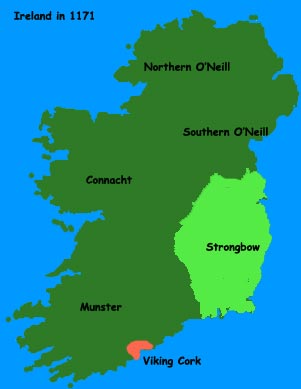
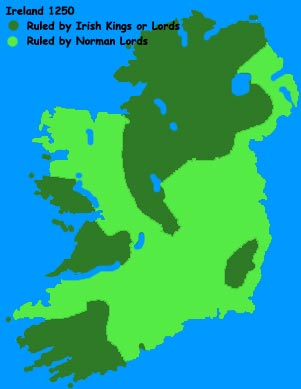
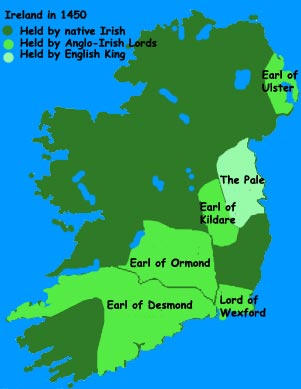
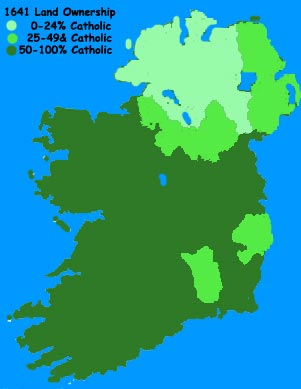
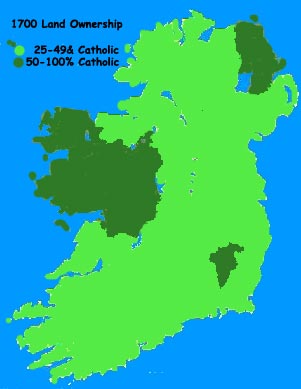
The English economy went into decline in the early 14th century. So neither people nor money were available to colonise Ireland. The Black Death plague swept Ireland from 1340 till 1360, reducing the population substantially. The towns were badly hit, and there more English than Irish died. About one third of the colonial population died. Pro rata to the size of the population at the time, it was a greater disaster than the famine in 1846. No new castles were built. The great Earls became stronger, more Irish, and more distant from the crown. The Justiciar in Dublin became weaker, and controlled only The Pale. The Earldoms became buffer zones between the Pale and the uncolonised areas still ruled by the Irish chiefs.
To try and reverse the slide away from the crown, the Statutes of Kilkenny were passed in 1366, outlawing intermarriage with the native Irish and proclaiming supremacy of the English language. Edward III's son the Duke of Clarence was the prime mover of the legislation. They were not repealed till 1613. Indeed the term "Irish enemies" was the official name for the Irish living outside the Pale.
Seal of Edward III
It is important to realise that even at the height of their influence (about 1300), the Normans only controlled about half of Ireland. They colonised the better lowland agricultural land in Leinster and Munster, leaving the entire north and west untouched except for the odd fort. Nor did they colonise the hilly areas of the south and east, such as the Wicklow Mountains. Irish chiefs held the rest of the country, each controlling a limited area, fighting border wars against either Norman colonists or neighbouring chiefs. So no cohesive opposition against the Normans existed, but there were continuous border skirmishes.
The English had similar border wars with the Welsh, Scots and the French (with the English enclaves there), so they did not have the money to keep a large standing army in all these areas. They would only to move an army to an area if there was profit to be gained or a threat to be met. For the rest of the time the most cost effective way to proceed was to devolve power to the local magnates, who had their own standing armies.
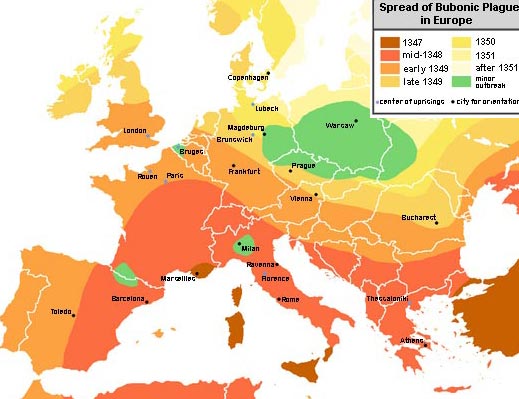
Hence with Ireland the crown's policy wavered between sending an English Deputy to Dublin, and appointing one of the Irish Earls as Deputy. The English Deputy had to bring and support his own troops from England, at considerable cost to the crown. There was not enough income from Ireland to pay the costs, but an English Deputy was beholden to the king, loyal to him and controlled by him. An Anglo-Irish Deputy like Ormonde or Kildare offered government at no cost, as they maintained their own armies, but they were much more difficult to control from London. So from 1300 until Cromwell the Deputyship swung between the English and the Anglo-Irish, and among the great earls in Ireland.
With the death of many of the Norman colonists in the plague, the Irish pastoralists slowly edged back into some of the colonised lands. Many farms and villages became deserted, and the revenues from Ireland started to dwindle. The crown then tried to restore revenues to their former level by increasing taxes. Resentment naturally grew among the colonists.
Visits by Richard II, arriving in Waterford in 1394 and 1399, did briefly extend the influence of the crown. But after he returned to England to unsuccessfully deal with Bolingbroke's rebellion, then that was the last the Ireland was to see of a reigning English monarch until William III landed with an army in 1689. For most of the Middle Ages the Deputy ruled with an army of less than 500 men, so his role was defensive rather than aggressive.
By 1355 David Meiller Grant held half the manor of Polroan. And by 1365 Curlody had passed into the hands of David Grant. Curlody then became the main stronghold of the Grants. The family held Polroan and Curlody until the Cromwellian confiscations of 1656. Carrigan describes the castle of the Grants as being well and strongly built, with five stories in all. Its position was unusual in that it was built on the side of a hill and not on level ground. There was no trace of any enclosing wall or fosse. The land all around was hilly and rocky. The glen underneath the castle had been marsh. In 1429 a statute of Henry VI, in an effort to consolidate the position of his supporters, offered a £10 subsidy to any man erecting a fortified castle at least 20 ft by 16 ft by 14 ft high. Perhaps Curlody is one of these castles.
The Grants now held their lands as free tenants of the Earls of Ormonde. It was not a happy time, law and order broke down, there was an exodus of the Old English back to England, there were constant wars, the tyranny of the great overlords increased, and there were major outbreaks of disease. The situation of war and plague were mirrored all over Europe. The effect on Ireland was to dry up the supply of colonists coming from England. Further, as plagues had reduced the number of Anglo-Irish, it became difficult to find tenants for the land that had already been colonised. Hence rents were stable, and Irish tenants were given leases within the area of Anglo-Norman influence.
From the climatic optimum of the 13th century, the climate cooled in the 15th and 16th centuries, and although this cooling may have only been a degree or so, it was enough to mean that wheat would no longer ripen in the cool dry fields of Ireland.
The external wars with France, and the internal Wars of the Roses in England coloured the course of events in Ireland for most of the 15th century. Richard, Duke of York, was appointed Lord
Lieutenant in 1447, and made Ireland into a Yorkist stronghold, with only the Earl of Ormonde remaining Lancastrian. When Richard was defeated at Ludlow in 1459, in an unsuccessful bid for the English crown, he returned to Ireland where he summoned an Irish parliament to pass a unilateral declaration of independence. Therefore when Henry VII gained the English throne in 1485, after the battle of Bosworth, he found that Ireland was still Yorkist under a strong Yorkist Lord Lieutenant, Garret More, Earl of Kildare. The two major attempts to overthrow Henry VII by Lambert Simnel and Perkin Warbeck both used Ireland as a launching point. This brought home to the English king the importance of the Lordship of Ireland, not only to control Ireland, but more importantly the danger if it fell into hostile hands.
It was another ten years before Henry VII was strong enough to assert his authority. In 1494 he sent his own son Henry to be Lord Lieutenant, together with a reliable Deputy, Sir Edward Poynings. Poynings passed a great many statutes, the best known being Poynings Law. This law effectively subjugated the Irish parliament, under it all legislation of the Irish parliament had to be approved by the English parliament.
But it is significant that Henry reappointed Kildare as Deputy for the rest of his reign. An indication that not even he could rule Ireland without the help of the great Earls, who by 1500 owned the whole of Ireland south of the Upper Boyne and Limerick.
Henry VIII succeeded to the throne in 1509, and the European perspective on the world was starting to change dramatically. The voyages of Columbus, Cabot and others had opened up the sea routes to America, Africa and India. In a world where control of the sea-lanes would be the key to wealth, the position of Ireland to the strategic defence of Britain became even more important. But the great Earls effectively continued to rule Ireland. The zenith of their power was perhaps reached in 1534 when Silken Thomas FitzGerald, Earl of Kildare, rose in revolt to claim the Lordship of Ireland, on the grounds that it was the gift of the pope, and as Henry VIII had been excommunicated, then he could no longer be Lord of Ireland.
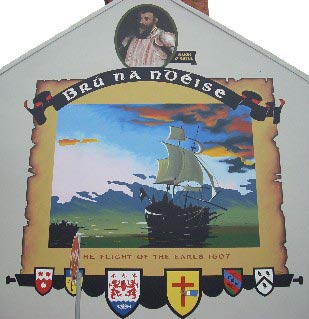
The English defeated Kildare at Maynooth, and his execution in 1537 opened the way for an effective conquest of Ireland by the English. The political and strategic pressures on Henry VIII impelled him to do something to bring the Irish under control. As he could not afford the cost of a full-scale war, he embarked on a policy of conquest by negotiation. By a declaration of 1541 he proclaimed himself to be "king" rather than "lord" of Ireland, hence removing the authority of the old papal grant. He tried to extend his rule by a policy of "surrender and regrant" under which the Irish chiefs were encouraged to surrender their land and acknowledge Henry as king. In return they received their lands back from Henry as a feudal grant plus an English title of nobility. This policy, like most English policies, caused very little real change in the situation in Ireland.
Flight of the Earls 1603
On Queen Mary's accession she then tried, and opened up two new counties with the plantations of Queens County and Kings County by planters of full English blood. But by the time of Elizabeth I's Irish parliament in 1560 only 10 counties and 28 towns were represented (Ireland has 32 counties today). This was the total extent of her remit. Little further was done by the English until they suffered a major defeat by the Earl of Tyrone in 1598. This convinced Elizabeth to take the problem seriously, and an army under Mountjoy finally defeated Tyrone on Christmas Eve 1601. Tyrone escaped, but he finally submitted to Mountjoy just before Elizabeth's death in 1603. So it is only from this date that England, for the first time, controlled the whole of Ireland.
James I became king in 1603, and it was he, with the flight of the Earls of Tyrone and Tyrconnel into exile in 1607, who embarked on the "final solution" to the Irish problem - with the Plantation of Ulster. The confiscation of the Earls lands in Ulster meant that it could be divided into small parcels and planted with Protestant settlers, mainly lowland Scots. The thinking was that if large land grants were made then they would quickly be sold, but small landowners would be more committed to stay and work the land themselves. The policy was so successful that the demography of Ireland today stills shows these Protestant settlers in Ulster.
With the complete conquest of Ireland, it could for the first time be ruled as one country. However new divisions arose with this new colonisation, between the Old English (the families, like the Grants, who had sustained their connection with England since their forebears had come to Ireland with the Normans, but who were largely catholic) and the New English, mainly Protestant settlers. The Old English could not merge with the new rapidly growing colony because they were catholic, and the new rulers were Protestant. Being a catholic was considered at this time as not being compatible with being loyal to the king.
The Catholic Church itself was split between the Old English and the Irish. As the pope had excommunicated Elizabeth, the question of allegiance by Catholics to her was a difficult one. The Old English tended to look for a formula that would make it possible. The Irish did not want to find such a formula. In 1620 Rome decided to maintain a full Episcopal system in Ireland, whereas in all other protestant countries they suspended normal church operations.
To maintain the protestant kingdom in a catholic country, James I sent Lord Carew to Ireland. And as was intended, Carew skilfully revised the electoral system to produce a narrow protestant majority in a parliament, which would otherwise have been controlled by the Old English Catholics.

Viscount Wentworth later Earl of Strafford
For the first half of the century the king raised money from Ireland by playing off the Old English against the New. Catholicism was tolerated among the Old English in return for money. And the New English paid money in return for a not too close scrutiny of the land titles.
The king's Deputy, Viscount Wentworth later Earl of Strafford, successfully maintained this policy from his appointment in 1632 until his recall to England in 1642. Charles then had him beheaded in a last ditch sop to parliament in order to try to ameliorate his own position with parliament.
By then Ireland was to enter perhaps its grimmest period of history. A period that would see fifty years of virtually continuous war and struggle. It would end with a completely new Protestant ascendancy emerging to become the rulers of Ireland.